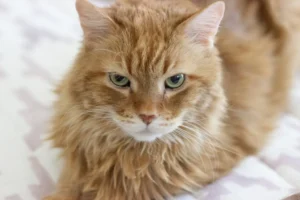Cats have long been depicted as villains in movies, TV shows, and literature. But why is this the case?
Cats have a mysterious and independent nature that can be misinterpreted as villainous behavior. Let’s explore the reasons behind this common stereotype.
Evolution of Cats as Villains
Cats have been typecast as villains in various forms of media for centuries, dating back to ancient Egyptian mythology where they were associated with the goddess Bastet, embodying both benevolence and fierceness. Over time, this dichotomy evolved in Western culture, with cats often depicted as cunning and mysterious creatures in folktales and literature. This portrayal as sly and deceitful animals has seeped into popular culture, shaping the way we perceive them as villains in movies, TV shows, and even cartoons. Whether it’s the Cheshire Cat in “Alice in Wonderland” or the conniving Siamese cats in “Lady and the Tramp,” cats are often portrayed as the antagonists, reinforcing the stereotype of them as nefarious characters.
Misconceptions About Cat Behavior
Despite their unfair portrayal, cats are not inherently villainous creatures. One common misconception that contributes to their negative stereotype is that cats are aloof and unloving. In reality, cats are affectionate animals that form strong bonds with their human companions. Another misconception is that cats are malicious and enjoy causing trouble. While they may exhibit mischievous behavior at times, it is typically out of curiosity or playfulness rather than a desire to cause harm. Understanding these misconceptions can help dispel the notion that cats are natural villains and instead appreciate them for the complex and endearing pets that they are.
Unique Insight or Angle: One unique insight to consider is that the association of cats with superstition and the occult throughout history has also contributed to their portrayal as villains. From witchcraft to black cats crossing your path, these superstitions have perpetuated the idea of cats as spooky and ominous creatures in popular culture. Understanding the historical context behind these beliefs can shed light on why cats have been consistently cast as villains in various forms of media.
Association with Witches and the Occult
Cats have long been associated with witches and the occult. In folklore, they were believed to be companions of witches, aiding them in their spellcasting and magical activities. This connection led to cats being viewed as mysterious and sinister creatures, ultimately shaping their portrayal as villains in various stories and myths. The black cat, in particular, was often linked to witches, with its dark fur and piercing eyes adding to its enigmatic allure. This association with the supernatural continues to influence the way cats are depicted in popular culture, reinforcing their role as antagonists in many narratives.
Cats in Popular Culture
From classic literature to modern films and television shows, cats have frequently been cast as villains in popular culture. In stories like Edgar Allan Poe’s “The Black Cat” and H.P. Lovecraft’s “The Cats of Ulthar,” felines are portrayed as symbols of malevolence and terror. In movies like “Pet Sematary” and “Coraline,” sinister cats add an extra layer of suspense and danger to the plot. Even in children’s cartoons like “Tom and Jerry,” the cat is often the antagonist, chasing the protagonist mouse with villainous intent. This widespread portrayal of cats as villains across various forms of media has solidified their reputation as cunning, enigmatic, and sometimes nefarious creatures in the eyes of the audience.
Additional Unique Insight:
- Cats’ agile and independent nature may contribute to their portrayal as villains. Their ability to move stealthily and unpredictably can make them seem mysterious and threatening, adding to their villainous allure. This trait, combined with their historical association with witches and the occult, creates a compelling narrative that positions cats as the perfect antagonists in many stories and cultural representations.
The Cat vs. Dog Debate
Cats are often portrayed as villains in comparison to dogs due to the contrasting stereotypes associated with each animal. While dogs are seen as loyal and loving companions, cats are sometimes unfairly labeled as sneaky and untrustworthy. This bias in favor of dogs has roots in societal preferences and cultural perceptions. Dogs are praised for their obedience and unwavering loyalty, traits that have elevated their status as beloved pets. In contrast, cats are often characterized as independent and aloof, leading to the belief that they are more likely to cause mischief or act in self-serving ways. This dichotomy between cats and dogs has perpetuated the misconception that cats are inherently villainous creatures, when in reality, they are simply different in their behaviors and preferences.
Cat Stereotypes in Society
Societal stereotypes play a significant role in shaping the image of cats as villains. Throughout history, cats have been associated with mysticism and witchcraft, leading to a perception of them as enigmatic and elusive creatures. These negative connotations have seeped into popular culture, where cats are frequently depicted as cunning and deceitful characters. Additionally, the internet has played a role in reinforcing these stereotypes, with viral videos often showcasing cats engaging in mischievous behavior. As a result, society has developed a bias against cats, viewing them with suspicion and wariness. This ingrained prejudice contributes to the perception of cats as villains, perpetuating a harmful narrative that fails to recognize the complexity and individuality of these animals.
Additional Insight:
- Despite these stereotypes, cats are complex creatures with unique personalities and behaviors. It is essential to approach them with an open mind and a willingness to understand their individual needs and preferences, rather than categorizing them based on preconceived notions. By challenging societal biases and giving cats the chance to be seen in a new light, we can begin to dismantle the villainous image that has unfairly been imposed upon them.
Cat Behavior Explained
Cats exhibit a range of behaviors that are often misunderstood by humans, leading to the misperception that they are villains. One common behavior is their tendency to be aloof or independent. Contrary to popular belief, this aloofness is not a sign of malice but rather a natural instinct for survival. Cats, as solitary hunters, are wired to be self-reliant and cautious. They may seem standoffish at times, but it’s simply their way of assessing their environment and ensuring their safety.
Furthermore, cats are known for their playful but sometimes aggressive behavior. Pouncing, scratching, and biting are all part of their predatory instincts. While these behaviors can be misinterpreted as aggression, they are actually ways for cats to hone their hunting skills and stay mentally and physically stimulated. Providing appropriate outlets for play, such as interactive toys and scratching posts, can help redirect these behaviors in a positive way.
Cats as Misunderstood Creatures
It’s essential to recognize that cats are often unfairly labeled as villains due to a lack of understanding of their natural instincts. One common misconception is that cats are spiteful or vindictive. In reality, cats do not possess the ability to hold grudges or seek revenge. Their behaviors are driven by instinct, not malice.
Additionally, certain behaviors such as marking territory, hiding, or hissing can be misinterpreted as aggressive or antisocial. However, these actions are simply a cat’s way of coping with stress or discomfort. By providing a safe and enriching environment for your feline companion, you can help them feel more secure and less likely to exhibit behaviors that are perceived as villainous.
Understanding Cats Better: Tips for Building a Positive Relationship
- Provide regular play sessions to fulfill your cat’s hunting instincts.
- Create safe spaces, like cozy hiding spots or elevated perches, where your cat can retreat when feeling overwhelmed.
- Offer plenty of vertical space for climbing and exploring, as cats feel most secure when they can survey their surroundings from above.
- Respect your cat’s boundaries and signals, such as tail flicking or flattened ears, to avoid triggering defensive behaviors.
- Consult with a veterinarian or animal behaviorist if you have concerns about your cat’s behavior to rule out any underlying medical issues.
Interesting Cat Facts
Cats have a complex nature that goes beyond their mischievous reputation. Did you know that cats have a unique grooming behavior? They lick their fur not just to stay clean, but also to regulate their body temperature. This fascinating self-care routine showcases their meticulous attention to detail. Another interesting fact is that cats have a specialized collarbone that allows them to always land on their feet when falling – a skill known as the ‘righting reflex.’ These facts highlight the intricate and intelligent nature of cats, dispelling common misconceptions about them being solely villains.
The Softer Side of Cats
Amidst their villainous portrayal, cats have endearing and lovable qualities that often go unnoticed. Cats are affectionate animals that form strong bonds with their owners. They show their love through gentle head butts, purring, and kneading – behaviors that demonstrate their affection and trust. Additionally, cats are incredibly independent creatures, displaying a sense of confidence and resilience. Their playful antics and quirky behaviors add a sense of joy and companionship to any home. By recognizing the softer side of cats, we can appreciate their unique personalities and strengthen our bond with these remarkable animals.
Alex, a passionate animal lover, has experience in training and understanding animal behavior. As a proud pet parent to two dogs and three cats, he founded AnimalReport.net to share insights from animal experts and expand his knowledge of the animal kingdom.




